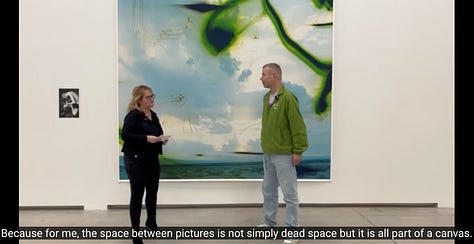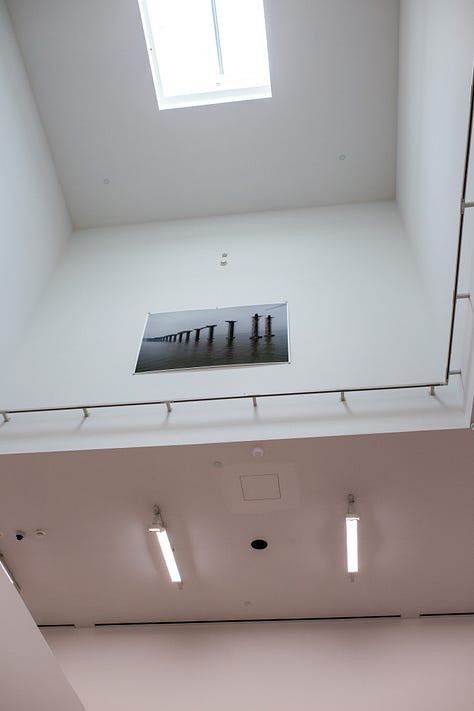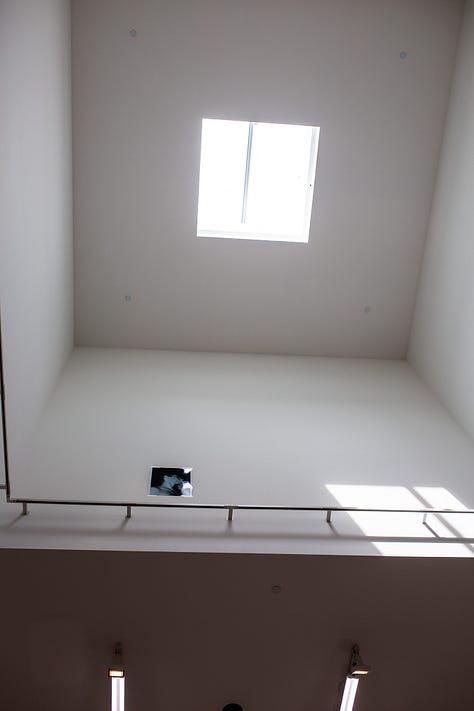Wolfgang Tillmans
April 7, 2023 - October 1, 2023
****.5
It’s instructive to recognize “To look without fear” is a major retrospective—Tillmans himself is the overarching subject of this sprawling exhibition, an arrangement of 350+ works that encompasses over 30 years of the German photographer’s still-active career. It’s also relevant to mention I am a big Tillmans fan, and so my appraisal should be weighed against its many layers of personal affection (though I will try to contain myself).
Here, Tillmans employs his famously formally-informal exhibition style, which arranges framed and unframed photographs in an unranked, unlabelled fashion, pinning or taping them onto the gallery’s walls during a process of onsite installation. Tillmans and his team personally undergo the task of each image’s placement prior to the show’s opening. (In an interview with the Goethe-Institut Toronto, Tillmans states, explicitly: “...for me, the space between pictures is not simply dead space but it is all part of a canvas.”) The show is a collaborative conversation spread across the AGO’s fifth floor, roaring and lulling between several interconnected white cubes and two dark room video installations.
I enjoy Tillmans’ hands-on methodology for 1) its immersive potential and 2) the intimacy it cultivates. You could sit and have a chat with Tillmans for hours, bouncing from wall to wall, dissecting each arrangement, and to the unknowing observer it would appear as if you were simply staring at a photo of a wrinkled t-shirt (“suit, 1997”) and dissociating—what could be both closer to and further from the truth? For the AGO, Tillmans banters with the gallery’s architect, Frank Gehry, placing an image (“Macau Bridge, 1993”) high up near the almost seven meter tall ceiling, its distance from the viewer and proximity to the skylight together making the bridge appear a hallucination—a dreamer’s staircase above Gehry’s defining spiralling steps.
Tillmans’ style of exhibition, which pointedly excludes the informational gallery placard in favour of inviting open approach, is an extension of Tillmans the artist—each visitor is encouraged to view the works “through their own eyes, and their own lives”, as Tillmans has said, time and time again, for previous showings and past exhibitions of his work. If not for his repetition, one could believe Tillmans simply for his earnestness. There has always been a conscientious, equitable system to the way Tillmans has looked to assign value. Much of the 1990s—the era in which he rose to prominence—saw Tillmans displaying both in magazines (notably the street style magazine “i-D”) and in contemporary art galleries and museums, considering both as equal spaces for his work to inhabit. Tillmans would go on to win the 2000 Turner Prize for “challenging the boundaries between art and photography and between the genres of portraiture, documentary and still life”, in part a statement on his ability to locate, identify, and at times imbue a vitality to instances of seemingly casual, everyday life. Three years later, for his 2003 exhibition at Tate Britain, “WOLFGANG TILLMANS: IF ONE THING MATTERS, EVERYTHING MATTERS”, he says of the show’s title: "I don't mean it as everything is the same, but that everything has the potential to be something, and that one should not close one's eyes just because we have pre-formed ideas about a value system—this is higher, this is lower”. Matthew Collings, among the funniest of Tillmans disparagers, once referred reductively to the artist as a “man who won Turner Prize…takes photographs of anything”. To be so close to the point!
It is Tillmans’ persistently unbarred gaze that animates the best of his work, the hallmark of an artist who reimagines genres by not quite considering them at all, and it is the through-line by which “To look without fear” is most successful. Many of the images on display in “To look without fear” can be conjured up online; heavy-hitters like “Lutz & Alex sitting in the trees, 1992”, “astro crusto, 2012”, hang ready for examination, often acting as markers for chapters in his career. In Room 5, Wall C, you can meet a friendly little Toucan (“Tukan, 2010”), whose portrait sits, in equal size, next to a candid photo of three boys playing xiangqi at night, under yellow streetlights in China (“Shanghai night, a, 2009”). Both are inkjet prints on paper, held up by binder clips. The yellow light of nighttime softly evinces the blue encircling the toucan’s deep black eyes. In Room 7, Wall B, hangs an enormous body of video static (“Sendeschluss/End of Broadcast I, 2014”), that, from far away, might seem to be simply a collage of black and white distortion, but upon approach reveals its bevy of colour. These are only 3 photographs of, again, over 350 works available on display, in addition to 2 video installations. If you consider each wall as a composition of its own, and each subsection of each wall as its own work as a part of a larger work, it is a dizzying experience to tally the ways in which “To look without fear” can be examined.
There is a way to interpret Tillmans’ work as corny, and certainly the immensity of the show is exacerbated by projects that can come across as rote, or banal. There are experimental efforts in Tillmans career, also on display here, that can exacerbate these feelings—”paper drop (star), 2006” and “Ostgut Freischwimmer, 2004” are iconic, identifiable Tillmans works that benefit largely by being Tillmans’ work. But the inclusion of these pieces are compulsory in a retrospective of Tillmans’ career, whose work always seems in conversation with his past and present, and whose extensive, prolific nature is the foundation by which his most sublime works have been formed. There are many works in here that are beautiful documentary works that could only exist with Tillmans’ commitment to his practice. We are lucky to see them. I like to think of the late, great Schjendahl, who wrote about this for the MOMA’s iteration:
“a series of unpeopled interiors that are littered with empty beer bottles and other morning-after detritus. These photographs shouldn’t amount to much, but to me they are stunningly lovely and, with only trace elements of melancholy, poetically more telling of communal ecstasy than any shots of the originating events could be. Think about mornings. They’re when the purest sense of what we are doing, or not doing, with our temporary habitation of the Earth sinks in.“
My favourite photo of Tillmans’ is on display in Room 10. In the exhibition guide issued by the AGO, it’s marked as the room’s first image, but only because the labeling proceeds from left-to-right; when you enter this final room, after encountering the enormity of Tillmans’ ouvre, you walk through room 10 from right-to-left (in this way, it is, chronologically, the last image you see). The image is a photograph from one of many queer nightlife scenes captured in Tillmans career, but to me (and to many) it is the most visceral—two hands grasping against someone’s hair, their eyes closed and mouth open. It’s called “Love (hands in hair), 1989”. I guess I’m a really corny guy, too.









